
Lavandula is a genus of 47 known species of flowering plants in the mint family, Lamiaceae. It is native to the Old World and is found in Cape Verde and the Canary Islands, and from Europe across to northern and eastern Africa, the Mediterranean, southwest Asia to India.

The Vitaceae are a family of flowering plants, with 14 genera and around 910 known species, including common plants such as grapevines and Virginia creeper. The family name is derived from the genus Vitis.
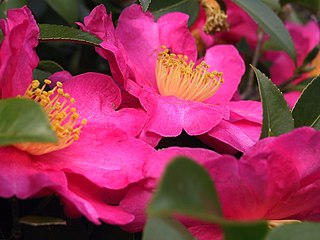
Camellia is a genus of flowering plants in the family Theaceae. They are found in tropical and subtropical areas in eastern and southern Asia, from the Himalayas east to Japan and Indonesia. There are more than 220 described species. Camellias are popular ornamental, tea and woody-oil plants that have been cultivated throughout the world for centuries. To date, over 26,000 cultivars, with more than 51,000 cultivar names including synonyms, have been registered or published.

The trifoliate orange, Citrus trifoliata, is a member of the family Rutaceae. Whether the trifoliate oranges should be considered to belong to their own genus, Poncirus, or be included in the genus Citrus is debated. The species is unusual among citrus for having deciduous, compound leaves and pubescent (downy) fruit.

Magnolia wilsonii, or Wilson's magnolia, is a species of Magnolia native to China, in the provinces of western Guizhou, Sichuan and northern Yunnan, where it grows in the forest understory at altitudes of 1,900-3,000 m, rarely up to 3,300 m.

Trifolium campestre, commonly known as hop trefoil, field clover and low hop clover, is a species of flowering plant native to Europe and western Asia, growing in dry, sandy grassland habitats, fields, woodland margins, roadsides, wastelands and cultivated land. The species name campestre means "of the fields".
Camellia pleurocarpa is a species of flowering plant in the family Theaceae. It is endemic to Vietnam.
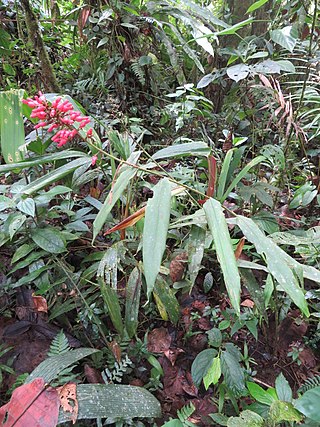
Renealmia sessilifolia is a species of flowering plant in the family Zingiberaceae. It is endemic to Ecuador. Its natural habitat is subtropical or tropical moist montane forests.
Millettia leucantha or sathon is a species of plant in the legume family, Fabaceae. It is a perennial flowering tree native to Indo-China – Cambodia, Laos, Myanmar, Thailand, and Vietnam – as well as Bangladesh and southern Yunnan province in China.
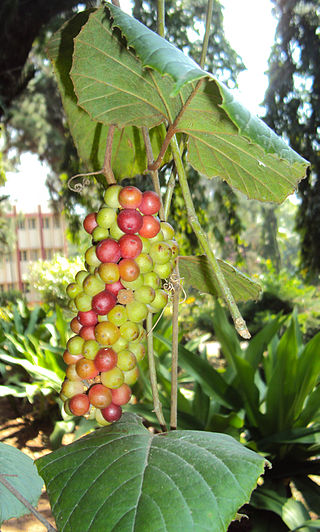
Ampelocissus is a genus of Vitaceae having 90 or more species found variously in tropical Africa, Asia, Central America, and Oceania. The type species, A. latifolia, was originally treated under its basionym, Vitis latifolia, and was collected from the Indian subcontinent.
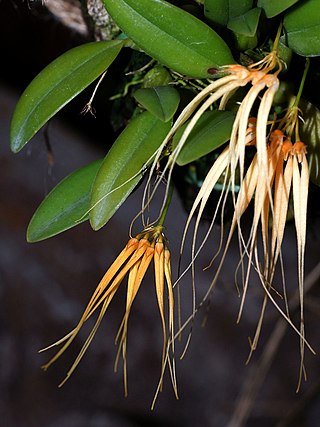
Bulbophyllum pecten-veneris is a flowering plant in the family Orchidaceae. It is a species of orchid that is also known as the yellow-flowered bulbophyllum or golden comb orchid.
Bulbophyllum chondriophorum is a flowering plant in the family Orchidaceae. Within the genus Bulbophyllum it is in section Cirrhopetalum.
Bulbophyllum evrardii is a flowering plant in the family Orchidaceae.
Bulbophyllum proboscideum is a flowering plant in the family Orchidaceae.
Bulbophyllum semiteretifolium is a flowering plant in the family Orchidaceae.
Bulbophyllum simondii is a flowering plant in the genus Orchidaceae.
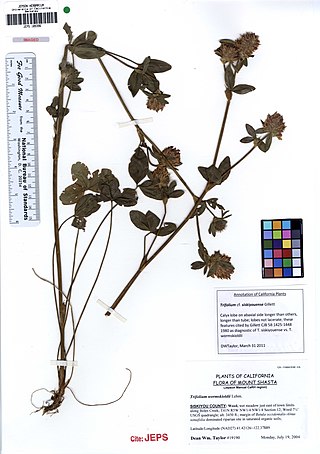
Trifolium siskiyouense, the Siskiyou clover, is a clover species endemic to the Klamath Mountains in the western United States.

Cleome viscosa, the Asian spiderflower or tick weed is an annual herb that grows up to a meter high. It belongs to the family Cleomaceae. It is considered an invasive species and is widely distributed in warm and humid habitats across the Americas, Africa and Asia, and in Australia. It is commonly found during the rainy season.
Amomum ovoideum is a widespread shade-demanding rhizomatous herb of the ginger family (Zingiberaceae) native to Southeast Asia. The plant bears fruits up to 2 cm (0.79 in) long, covered by slender, soft, red spines. When dried, the fruit produces cardamom seedpods similar to other cardamom spice plants.










